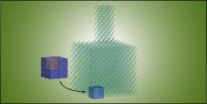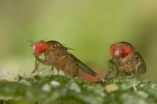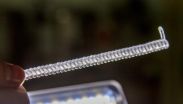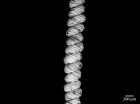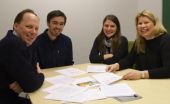(Press-News.org) COLUMBUS, Ohio – Chronic stress that produces inflammation and anxiety in mice appears to prime their immune systems for a prolonged fight, causing the animals to have an excessive reaction to a single acute stressor weeks later, new research suggests.
After the mice recovered from the effects of chronic stress, a single stressful event 24 days later quickly returned them to a chronically stressed state in biological and behavioral terms. Mice that had not experienced the chronic stress were unaffected by the single acute stressor.
The study further showed that immune cells called to action as a result of chronic stress ended up on standby in the animals' spleens and were launched from that organ to respond to the later stressor.
Mice without spleens did not experience the same reactivation with the second stressor, signifying the spleen's role as a reservoir for primed immune cells to remain until they're activated in response to another stressor.
The excessive immune response and anxiety initiated by a brief stressor mimic symptoms of post-traumatic stress disorder.
The Ohio State University scientists are cautious about extending their findings to humans. But they say their decade of work with this model of stress suggests that the immune system has a significant role in affecting behavior. And they are the first to study this re-establishment of anxiety in animals with a later acute stressor.
"No one else has done a study of this length to see what happens to recovered animals if we subject them again to stress," said Jonathan Godbout, a lead author of the study and associate professor of neuroscience at Ohio State. "That retriggering is a component of post-traumatic stress. The previously stressed mice are living a normal rodent life, and then this acute stress brings everything back. Animals that have never been exposed to stress before were unaffected by that one event – it didn't change behavioral or physiological properties."
The research is published online in the journal Biological Psychiatry.
These scientists previously determined that in mice with chronic stress, cells from the immune system were recruited to the brain and promoted symptoms of anxiety. The findings identified a subset of immune cells, called monocytes, that could be targeted by drugs for treatment of mood disorders – including, potentially, the recurrent anxiety initiated by stress that is a characteristic of PTSD.
The research reveals new ways of thinking about the cellular mechanisms behind the effects of stress, identifying two-way communication from the central nervous system to the periphery – the rest of the body – and back to the central nervous system that ultimately influences behavior.
"We haven't proffered that there is a cellular component to PTSD, but there very well might be. And it's very possible that it sits in the periphery as we've been describing in the mouse," said John Sheridan, senior author of the study, professor of oral biology and associate director of Ohio State's Institute for Behavioral Medicine Research.
In this model of stress, male mice living together are given time to establish a hierarchy, and then an aggressive male is added to the group for two hours at a time. The resident mice are repeatedly defeated, and this social defeat over six days leads to an inflammatory immune response and anxiety-like behavior.
This kind of stress triggers the sympathetic nervous system and a commonly known fight-or-flight response. While the response is important for survival, prolonged activation over an extended period of time can have negative effects on health.
After subjecting a group of mice to this chronic stress, researchers tested biological and behavioral hallmarks of the stress response 14 hours and eight days later. At both time points, compared to control mice, the stressed mice showed higher levels of pro-inflammatory proteins in the bloodstream and accumulation of monocytes in the brain, which the scientists had previously linked to anxiety-like behavior – in this case, taking a long time to enter an open space.
"Eight days is a long time for anxiety to persist in a mouse," Sheridan noted.
By the 24-day point, these markers and behaviors in the stressed mice had returned to baseline levels.
Three groups of mice – the control mice, newly introduced mice to the study and the stress-sensitized mice – were then subjected to acute social defeat: a single two-hour exposure to an aggressive male.
Biological and behavioral markers remained unchanged in the unstressed mice. Within 14 hours after the acute event, the stress-sensitized mice had returned to the chronically stressed state, with higher pro-inflammatory proteins in their blood and a return of anxiety, suggesting monocytes had traveled to the brain to bring on those symptoms.
"That one exposure to an acute stressor produced a similar pattern to what we'd expect to see if they had experienced the chronic stress of repeated social defeat," Godbout said.
Because a primed immune cell type persisted in the spleen, the researchers removed the spleens of mice after the repeated social defeat-induced sensitization. After that spleen removal, the researchers found that the stress-sensitized mice were no longer sensitive to the acute stressor and the re-establishment of anxiety. The scientists also did not detect immune cell trafficking to the brain or anxiety-like behavior. This finding pointed to the spleen as a source of immune cells responding to the acute stressor.
"Our colleagues who study behavior talk about sensitization," Sheridan said. "Clearly, the repeatedly stressed mice were sensitized. What we're adding is that sensitization is associated with a specific cell type that resides in the spleen after the initial sensitization.
"The key is those cells. They originate in the bone marrow but in terms of sensitization, the spleen is a significant organ."
Sheridan also noted that other scientists are testing blood samples of PTSD patients for biomarkers such as immune cells or pro-inflammatory proteins that might indicate the patients are in a stress-sensitized state.
"This work will validate some of their approaches," he said.
From here, the researchers plan to compare the profiles of immune cells that travel to the brain versus the spleen during the stress response.
INFORMATION:
This work was supported by the National Institute of Mental Health and the National Institute on Aging.
Additional co-authors, all from Ohio State, include Eric Wohleb, Daniel McKim, Daniel Shea, Nicole Powell and Andrew Tarr of oral biology (Wohleb and McKim are also affiliated with neuroscience).
Contacts: Jonathan Godbout, (614) 293-3456, Jonathan.Godbout@osumc.edu; or John Sheridan, (614) 293-3571, John.Sheridan@osumc.edu
Written by Emily Caldwell, (614) 292-8310; Caldwell.151@osu.edu
Study in mice raises question: Could PTSD involve immune response to stress?
After chronic stress, primed immune cells in spleen lead to excessive reaction to later event
2014-02-20
ELSE PRESS RELEASES FROM THIS DATE:
Nanoscale pillars could radically improve conversion of heat to electricity
2014-02-20
University of Colorado Boulder scientists have found a creative way to radically improve thermoelectric materials, a finding that could one day lead to the development of improved solar panels, more energy-efficient cooling equipment, and even the creation of new devices that could turn the vast amounts of heat wasted at power plants into more electricity.
The technique—building an array of tiny pillars on top of a sheet of thermoelectric material—represents an entirely new way of attacking a century-old problem, said Mahmoud Hussein, an assistant professor of aerospace ...
Developing countries face 'leading medical scourge of developed countries'
2014-02-20
(Garrison, NY) Chronic illness, already a major and expensive problem in developed countries, is rapidly increasing in developing countries, adding to the longstanding burden caused by high rates of infectious diseases. However, poor countries will not be able to afford the costly medical technologies that wealthy countries use to treat chronic conditions, including heart disease, stroke, cancer, pulmonary disease, and diabetes, writes Daniel Callahan, cofounder of The Hastings Center.
Callahan examines this trend and concludes that it calls for a new, more economically ...
Long-term daily multivitamin supplement use decreases cataract risk in men
2014-02-20
SAN FRANCISCO – Feb. 20, 2014 – Long-term daily multivitamin supplement use may lower cataract risk in men, according to a study of nearly 15,000 male physicians published this month in Ophthalmology, the journal of the American Academy of Ophthalmology.
Past observational studies have indicated a relationship between nutritional supplement use and eye health. However, randomized trial data on the effects of long-term multivitamin supplement use and risk of eye diseases are limited and, in some cases, non-existent. To address this, researchers based at Brigham and Women's ...
Extreme weather decides distribution of insects
2014-02-20
As climate change is progressing, the temperature of our planet increases. This is particularly important for the large group of animals that are cold-blooded (ectothermic), including insects. Their body temperature is ultimately determined by the ambient temperature, and the same therefore applies to the speed and efficiency of their vital biological processes.
But is it changes in average temperature or frequency of extreme temperature conditions that have the greatest impact on species distribution? This was the questions that a group of Danish and Australian researchers ...
UT Dallas-led team makes powerful muscles from fishing line and sewing thread
2014-02-20
An international team led by The University of Texas at Dallas has discovered that ordinary fishing line and sewing thread can be cheaply converted to powerful artificial muscles.
The new muscles can lift a hundred times more weight and generate a hundred times higher mechanical power than the same length and weight of human muscle. Per weight, they can generate 7.1 horsepower per kilogram, about the same mechanical power as a jet engine.
In a paper published Feb. 21 in the journal Science, researchers explain that the powerful muscles are produced by twisting and ...
Bioengineered growth factors lead to better wound healing
2014-02-20
When we are wounded, our bodies naturally begin a process of repair of the damaged tissue. This process is mediated by biological molecules called growth factors, which are proteins that occur naturally in our cells and guide processes ranging from embryonic development to healing. Given their regenerative role in the body, growth factors have been investigated for use in drugs but with limited success. Publishing in Science, an EPFL group has used bioengineering to significantly improve the efficacy of clinical growth factors in the context of soft tissue and bone repair, ...
Previous rapid thinning of Pine Island Glacier sheds light on future Antarctic ice loss
2014-02-20
New research, published this week in Science, suggests that the largest single contributor to global sea level rise, a glacier of the West Antarctic Ice Sheet, may continue thinning for decades to come. Geologists from the UK, USA and Germany found that Pine Island Glacier (PIG), which is rapidly accelerating, thinning and retreating, has thinned rapidly before. The team say their findings demonstrate the potential for current ice loss to continue for several decades yet.
Their findings reveal that 8000 years ago the glacier thinned as fast as it has in recent decades, ...
Scientists create powerful artificial muscle with fishing line
2014-02-20
Researchers are using fibres from fishing line and sewing thread to create inexpensive artificial muscles that could be used in medical devices, humanoid robots, prosthetic limbs, or woven into fabrics.
In a study published today in Science, international researchers, including University of British Columbia Electrical and Computer Engineering professor John Madden and PhD candidate Seyed Mohammad Mirvakili, detail how they created inexpensive artificial muscles that generate far more force and power than human or animal muscles of the same size.
"In terms of the strength ...
Unstable Atlantic deep ocean circulation under future climate conditions
2014-02-20
Today, deep waters formed in the northern North Atlantic fill approximately half of the deep ocean globally. In the process, this impacts on the circum-Atlantic climate, regional sea level, and soak up much of the excess atmospheric carbon dioxide from industrialisation — helping to moderate the effects of global warming. Changes in this circulation mode are considered a potential tipping point in future climate change that could have widespread and long-lasting impacts including on regional sea level, the intensity and pacing of Sahel droughts, and the pattern and rate ...
Sequencing hundreds of nuclear genes in the sunflower family now possible
2014-02-20
Advances in DNA sequencing technologies have enormous potential for the plant sciences. With genome-scale data sets obtained from these new technologies, researchers are able to greatly improve our understanding of evolutionary relationships, which are key to applications including plant breeding and physiology.
Studies of evolutionary (or phylogenetic) relationships among different plant species have traditionally relied on analyses of a limited number of genes, mostly from the chloroplast genome. Such studies often fail to fully or accurately resolve phylogenetic ...
LAST 30 PRESS RELEASES:
Shark biology breakthrough: Study tracks tiger sharks to Maui mating hub
Mysterious iron ‘bar’ discovered in famous nebula
World-first tool reduces harmful engagement with AI-generated explicit images
Learning about public consensus on climate change does little to boost people’s support for action, study shows
Sylvester Cancer Tip Sheet for January 2026
The Global Ocean Ship-Based Hydrographic Investigations Program (GO-SHIP) receives the Ocean Observing Team Award
Elva Escobar Briones selected for The Oceanography Society Mentoring Award
Why a life-threatening sedative is being prescribed more often for seniors
Findings suggest that certain medications for Type 2 diabetes reduce risk of dementia
UC Riverside scientists win 2025 Buchalter Cosmology Prize
SETI Institute opens call for nominations for the 2026 Tarter Award
Novel theranostic model shows curative potential for gastric and pancreatic tumors
How beige fat keeps blood pressure in check
Fossils reveal ‘latitudinal traps’ that increased extinction risk for marine species
Review: The opportunities and risks of AI in mental health research and care
New map reveals features of Antarctic’s ice-covered landscape
Beige fat promotes healthy vascular function and blood pressure in mice
Chronic low-dose pesticide exposure reduces the life span of wild lake fish, China-based study shows
Tiny earthquakes reveal hidden faults under Northern California
Long-term pesticide exposure accelerates aging and shortens lifespan in fish
Professor Tae-Woo Lee's research group develops groundbreaking perovskite display technology demonstrating the highest efficiency and industry-level operational lifetime
The “broker” family helps tidy up the cell
Ecology: Mummified cheetahs discovery gives hope for species’ Arabic reintroduction
Researchers survey the ADHD coaching boom
Air pollution and cardiac remodeling and function in patients with breast cancer
Risk of suicide in patients with traumatic injuries
Post–intensive care syndrome
The lifesaving potential of opioid abatement funds
The Frontiers of Knowledge Award goes to Allan MacDonald and Pablo Jarillo-Herrero for their discovery of the “magic angle” enabling science to transform and control the behavior of new materials
Discovery reveals how keto diet can prevent seizures when drugs fail
[Press-News.org] Study in mice raises question: Could PTSD involve immune response to stress?After chronic stress, primed immune cells in spleen lead to excessive reaction to later event
